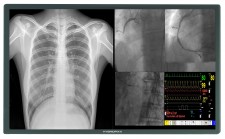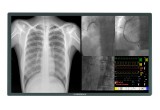
Latest Medical Technology (News Update): Ampronix discusses the 4K 8MP Imaging Advancements Happening in the Catheterization Laboratories
Orange County, California, May 3, 2017 (Newswire.com) - A Catheterization Laboratory is an instrumentally vital aspect of any hospital or healthcare facility. Commonly referred to as cath lab, this type of examination room is equipped with diagnostic imaging technology to give physicians visual access to chambers and arteries of the heart. In these spaces, a team of physicians perform life-saving procedures including coronary angiography, catheterization, balloon angioplasty, percutaneous coronary intervention, congenital heart defect closure, stenotic heart valves, and pacemaker implantations.
These procedures would not have been developed without the appropriate technology to facilitate the imaging process. In fact, cath lab operations depend completely on medical displays, which allow physicians to visualize a patient internally and perform the necessary procedure.
"Ampronix is dedicated to providing superior solutions to medical professionals that come without compromise. With our latest creation, Hybridpixx, we move forward with our goal to facilitate optimized patient care and improved physician workflow."
Ampronix Media Publisher, Communications Specialist
Although there have been considerable technological advancements in efficient cath lab construction, the dependence on X-rays for imaging has persisted through every transition. From the decision to purchase analog or digital modalities, to choosing a single or bi-plane system, there are endless customization possibilities. A typical cath lab consists of a C-arm, image intensifier, X-ray tubes, and several displays.
Advantageously, the digital age has ushered in an era of improvements to imaging technology that emit less radiation and simultaneously give physicians visual clarity. The adoption of CRT monitors in the cath lab inherently changed the way in which they ran.
In the early cath labs, all information was conveyed through film. The X-rays utilized were high-dose while producing low-quality images, which were printed on 16-mm or 35-mm film. Back then, radiologists would spend almost their entire day in darkrooms to process images while ample storage space was filled with boxes of film.
With the implementation of picture archiving and communication systems (PACS), the transition from analog to digital technology was concretized. PACS is an all-in-one program that provides electronic storage, retrieval, distribution, and presentation of radiology images.
Following CRT displays was the advent of LCD screens. Many upgraded to these monitors since they are slimmer, portable, and offer higher resolution images. In the cath lab, there is typically four to six CRT or LCD displays in use. Whereas a majority of the screens are utilized for hard images, one is always for monitoring physiological attributes like a patient’s heart rate or blood oxygen level.
We are witnessing yet another transition in medical monitors, as many professionals are updating from LED displays to ultra-high definition 4K technology. Many healthcare facilities have already or are currently in the process of upgrading their medical displays to this resolution, which provides a level of visibility previously unknown to physicians. During critical surgeries and procedures, increased clarity and sharper details can mean the difference between saving or losing a life.
Instead of making use of four to six displays, many are instead opting to update their displays with one large UHD 4K display. When a UHD display is combined with a video manager, it has the ability to become customizable with a variety of layout options and editing tools like magnification. The design is easier to use and provides a higher resolution, making its adoption an easy choice as it facilitates precise procedures and minimally invasive surgeries.
Although the advent of this technology has fostered improved patient care, the concessions made could prove to be detrimental and may demand considerable attention. Specifically, departing from the LED model to the 4K display system introduces issues with maintenance and safety.
With four to six displays in the cath lab, there are preventative measures in place that guarantee a backup option should a monitor burn out. In critical imaging procedures like angioplasty, mere seconds without visibility become crucial moments; a single display makes cath labs extremely susceptible to all the risks associated.
To solve this issue, some displays are equipped with back-up monitors that fold out, if needed. However, this is a sacrifice that presents limited visual acuity. When this type of situation unravels, the entire procedure must be halted and the patient sutured up, as technicians attempt to remedy the problem.
Furthermore, any display failure amounts to an entire cath lab rendered obsolete until a replacement or repair solution is provided. The turnaround time for either of those protocols, however, takes several weeks.
SOLUTION
There are many variables healthcare providers must consider when deciding what upgrades should be made. With cath lab procedures in mind, we created Hybridpixx to facilitate improved, safe, and reliable care without compromise.
The pending patent Hybridpixx touts an ingenious design that garners all the advantages of 4K UHD display, while mitigating the dangers associated with a single large display. The mount holds two 58 inch displays in place, so if the primary display fails, a back-up display with exactly the same parameters is ready. With a modular connection, the wireless display can be easily switched in under a minute.
Hybridpixx has a streamlined design, which makes the display easily replaceable to simplify the maintenance process. Furthermore, the decreased reliance on servicing makes the Hybridpixx a cost-effective solution since a Biomedical engineer is the only individual needed to replace the monitor.
Available in 58 inches, the 4K UHD monitor can be employed in both analog and digital cath labs. With the option to purchase our video manager, all the benefits of customizable layouts and modification are possible as well. Additionally, it can be utilized in a variety of spaces, including hybrid operating rooms that facilitate both surgical and interventional procedures.
Ampronix is dedicated to providing superior solutions to medical professionals that come without compromise. With our latest creation, Hybridpixx, we move forward with our goal to facilitate optimized patient care and improved physician workflow.
Contact Ampronix:
Email: info@ampronix.com
International Sales: +1 949-273-8000
Domestic Sales: 1800-400-7972 for US and Canada
Follow Us:
Facebook, Twitter, LinkedIn
About Ampronix
Ampronix is a renowned authorized master distributor of the medical industry's top brands, as well as a world-class manufacturer of innovative technology. Since 1982, Ampronix has been dedicated to meeting the growing needs of the medical community with its extensive product knowledge, outstanding service, and state-of-the-art repair facility. Ampronix prides itself on its ability to offer tailored, one-stop solutions at a faster and more cost-effective rate than other manufacturers. Ampronix is ISO 13485:2003, ISO 9001:2008, and ANSI/ESD S20.20-2014 certified.
Source: www.Ampronix.com
Share:




